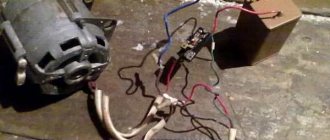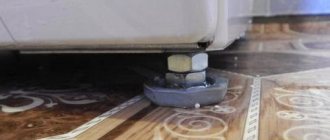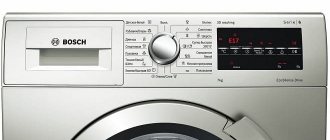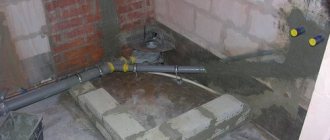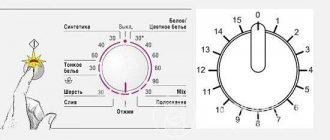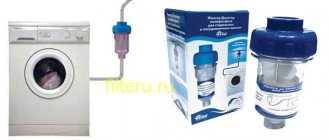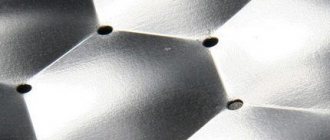One of the most common problems in the operation of a washing machine is a complete or partial breakdown of the drum, as a result of which it begins to rotate poorly or not at all. In this case, determining the cause of the malfunction is the most important step, which will determine further actions. The most common reasons why the washing machine drum does not spin well include:
- overload of laundry;
- damaged engine drive belt;
- engine breakdown;
- malfunction of the carbon brushes of the electric motor;
- imbalance of the drum mechanism.
Why did the drum stop?
To understand why the drum stopped rotating, you need to analyze how the washer worked before it stopped and diagnose the equipment. It is necessary to find out the cause of the malfunction and take measures to eliminate it. Usually the main container “freezes” in place due to:
- problems with the drive belt or drum “wheel” (perhaps the reason is both the rubber band and the pulley);
- a foreign object that has fallen inside the tank. It gets stuck between its walls and the drum and blocks the rotation of the latter;
- failure of the engine coil;
- severe wear of the motor electric brushes. The carbon rods wear out and cannot fully perform their functions;
- damage to the semiconductor elements of the main control module;
- erasing the motor slats.
The list of reasons why the washing machine may not spin the drum is far from complete. The simplest washing machine is a whole set of components, circuits, connections, and individual elements, the failure of which can cause the rotation to stop.
You should start self-diagnosis of your Beko machine with the simplest thing, discarding the reasons one by one. If you encounter difficulties checking individual components, you can seek professional help.
Features of repairing top-loading washing machines
Top-loading washing machines are compact in order to save space in the room, many people prefer them. The small size of the unit creates certain difficulties for disassembly and diagnostics. Before you decide to fix the breakdown yourself, you should know the features of repairing washing machines of this design:
- long and difficult disassembly;
- access to nodes is difficult;
- complexity of the device, special equipment is required;
- risk of accidental damage to other parts due to compactness.
Transmission mechanism
What actions to take first? In most cases, the Beko stops turning the drum due to problems with the drive belt. The rubber band may have broken or fallen off. If this is a one-time “promotion”, then it will be enough to buy a new element, remove the back panel of the washing machine and pull it onto the drum and motor pulley.
If the drive belt falls off regularly even after replacement, you will have to “dig” deeper to rule out pulley failure.
A new rubber band that comes off the “wheel” again after a few washes is a symptom of a serious problem. To check for damage to the drum pulley, you must:
- turn off the power to washing equipment;
- turn off the shut-off valve responsible for the water supply;
- pull out the washer to gain access to its back;
- remove the service hatch or rear panel (depending on the Beko machine model);
- inspect the drum pulley (represents a large wheel). If it is in perfect condition, you can tighten the drive belt into place. If there are any defects or deflections on the surface, the circle will have to be changed;
- take a look at the pulley mounted on the motor shaft. If the circle is deformed or damaged, be sure to reinstall the wheel.
If you find signs of wear, cracks, bends and other defects on the pulley, it is better not to put off replacement. In fact, reinstalling the drum wheel is not difficult; even a beginner can do it. All you need to do is purchase a similar circle, unscrew the fixing bolt, remove the damaged element and put on a new one. Let's analyze the upcoming algorithm of actions in more detail.
- Using a wooden block, block the movement of the drum “wheel”. If the circle is deformed, then there is no need to take care of it. It is important to preserve the screw and threads during the process, so you should proceed carefully.
- Spray the center bolt with WD-40. Wait half an hour for the substance to take effect.
- Take a wrench of a suitable size and carefully unscrew the screw. In this case, you do not need to press too hard on the structure so as not to damage the bolt and thread.
- Remove the old "wheel".
- Place the new pulley on the shaft and secure it with the mounting bolt.
Experts recommend replacing the drive belt at the same time as the drum pulley.
There is nothing difficult about replacing a wheel. It is very important not to overdo it here, so as not to break the thread. When the Beko machine repair is complete, check with your hand how freely the drum rotates, then run a test wash.
Electric motor
In this case, the problem may be worn graphite motor brushes. If they are so worn out that they no longer come into contact with the commutator and do not create the necessary electromagnetic field, so that the engine does not start, then they can only be replaced with new ones. Perhaps the problem is in the motor itself, and a short circuit or break in its winding has occurred. This rarely happens, but given the instability of voltage in the domestic network, it is quite possible. Or maybe leaks are to blame. Here you can’t do without diagnostics in a workshop - this is a serious and expensive breakdown.
Foreign body in the tank
Equipment repair technicians tirelessly talk about the danger caused by foreign solid objects that get into the washing machine tank. They tell how expensive repairs such a situation can turn out to be. Despite this, users often forget to check their pockets before loading items into the drum and neglect the recommendation to wash bras in special bags. Then, coins, pins, nails, paper clips, bones from bodices, and buttons get stuck between the tank and the drum.
It wouldn’t be so bad if the objects lay quietly at the bottom of the tank. However, sometimes they cause the drum to wedge and can cause damage to the plastic tank. In this case, you will have to replace the entire assembly, and this is a rather expensive repair.
If the drum is jammed for this reason, do not try to unscrew it manually or start the wash cycle. It is important to remove the stuck object from the washing machine tub as soon as possible. This can be done through the hole in the drain pipe or heating element.
If on your Beko model the heating element is located in the rear of the case, then it is better to get to the stuck small items in this way. It is necessary to remove the service hatch of the machine, disconnect the power supply from the heating element, loosen the fastening nut and pull the heater out. The resulting hole is enough to easily remove from the tank an object blocking the rotation of the drum.
When the heating element is in front, it is better to discard the idea of reaching a foreign object through its opening. This will involve removing the front panel of the case, which is quite difficult to do. It is much easier to try to remove stuck small things as follows:
- drain the water from the system through a garbage filter;
- lay the machine gun on its side;
- loosen the clamp securing the drain pipe, disconnect the hose from the tank;
- remove the foreign object through the drain hole.
After the problem is resolved, check the drum movement. If it rotates freely, you can assemble the Beko machine and continue to use the equipment.
How to avoid breakdown
In order for your home assistant to work flawlessly for a long time, you must follow several rules:
- Install the device strictly according to the instructions.
- Use high-quality detergents and water hardness softeners.
- Observe drum loading standards.
- Before loading dirty clothes, empty pockets and close zippers.
- Clean regularly, either manually or using a special program.
- If the electrical current parameters in the network deviate from the norm, use a voltage stabilizer.
- After completing the wash, disconnect the unit from the power supply.
It could be the motor
If during the diagnostics it turns out that the reason for the drum stopping is not in the drive belt, pulley or foreign object, you will have to check the engine. You should start inspecting the motor with its electric brushes and coil. The algorithm of actions will be as follows:
- disconnect the machine from the network, close the shut-off valve;
- disconnect the drain and inlet hoses from the body;
- lay the washing machine on its left side;
- take a photo of the diagram for connecting the wires to the engine, then disconnect the contacts;
- Unscrew the bolts securing the motor;
- remove the assembly from the housing;
- Using a multimeter, check the resistance of the motor coil. Having discovered that the part has burned out, you will have to replace it;
- pull out the brushes located on the sides of the motor. If even one of them is very worn out, you need to change the pair.
If everything is in order with the brushes and coil, the reason for blocking the drum movement may be a break in the wiring of the engine or damage to the lamellas. You can understand that the motor is really faulty by connecting it directly. If the worst is confirmed, the engine will have to be changed. It is not advisable to repair it, because it is not clear whether boring the lamellas or rewinding will lead to any results or not.
What can you do right away?
We calm down, turn off the machine with the button on the panel and unplug the cord from the outlet. We cover the floor with rags, find the drain filter on the front panel below, place a container (scoop, suitable container) under it, open it and drain the water. We take the laundry out of the machine and figure it out further.
We determine when the drum stopped. If during the spin cycle, the laundry will remain simply wet, without any signs of soapiness. If you wash it, things will be powdery.
You need to try to spin the drum by hand. Did not work out? Rotation is physically interfered with by a foreign body or a failed part. When the drum spins while the machine is turned off, the reason is hidden in the electronics.
The drain filter plug is unscrewed counterclockwise, and if you can’t pull it out by hand, you can use pliers
And one moment. A common consequence of drum immobility is the usual overload. Try splitting the laundry in half and restarting the wash with less “work.”
Modern washing machines are equipped with special sensors that monitor the weight: if it is exceeded, they stop the process. On some models this information is displayed on the display.
Don't forget to check the external conditions that affect the operation of the machine. Some washing machines are equipped with sensors that are sensitive to water pressure parameters.
While the user is disassembling the device and changing parts, a pinched hose, a burst gasket or a dirty filter will not alert you to attention.
"Electronic" problem
The most difficult thing is if the washing machine drum stops rotating due to a failure of the main control unit. Here, it is not worth undertaking independent repairs without certain knowledge and experience. Only a specialist can identify the cause of damage to the control board and eliminate it without harming the equipment. The technician, using special instruments, will correctly ring all the semiconductors and make a decision on the possibility of repair or the need to replace the unit.
Why is module failure considered one of the reasons for drum stopping? Usually, the problem lies in burnt-out triacs responsible for controlling the collector motor of the washing machine. However, this is just one of the nuances that the master needs to check; in fact, the problem may be completely different.
If the main suspicions fall on the electronics of the washing machine, it is better to entrust the diagnosis and repair of the machine to professionals.
By delving into the “brain” of the machine yourself, without the skills and experience, you can further aggravate the situation and completely break the control board. This will lead to a significant increase in the cost of repairs.
Interesting:
- Indesit washing machine does not spin the drum
- Reviews of Beko dishwashers
- Ardo washing machine does not spin the drum
- Beko washing machines
- Drum won't spin in Samsung washing machine
- Damage to Daewoo washing machines
Reader comments
- Share your opinion - leave a comment
Useful tips
In order for the device to serve you as long as possible, it is enough to follow the simple advice of experts. Be sure to use only special powders designed specifically for automatic machines. They contain components that regulate foaming. If you use a detergent for hand washing, the excessively formed foam can go beyond the drum and damage equipment parts, the troubleshooting of which can take a lot of time and money.
You should not get carried away with the amount of powder. A tablespoon of product will be enough for one wash. This way you will not only save powder, but rinsing will also be more effective.
Excess detergent can cause a leak, which is caused by a clogged filler pipe.
When loading laundry into the machine, make sure there are no foreign objects in the clothing pockets. Wash small items such as socks, handkerchiefs, bras, and belts in a special bag. For example, even a small button or sock can clog the drain pump and damage the tank or drum of the unit. As a result, the washing machine does not wash.
After each wash, leave the loading hatch door open - this will prevent the formation of high humidity, which can lead to oxidation of aluminum parts. Be sure to turn off the power supply after finishing the device and turn off the water supply valve.
How to replace bearings in a Beko washing machine, see below.
